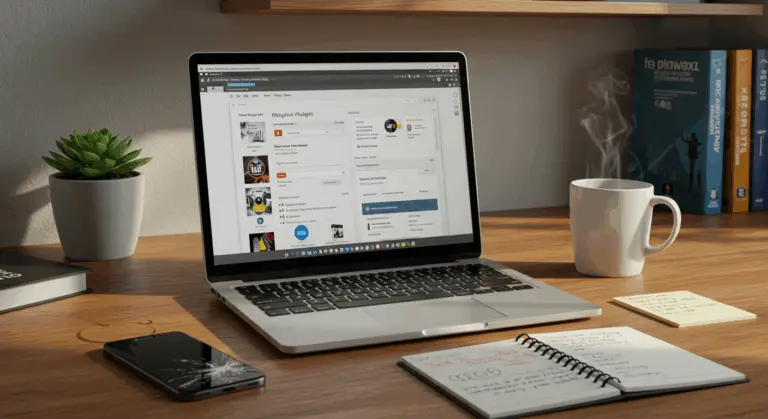Understanding WordPress Themes – What You Need to Know
WordPress themes are pre-designed templates that determine your website’s overall appearance, layout, and functionality. Think of them as your website’s ‘outfit’ – the visual framework that greets every visitor. They go beyond simple aesthetics; themes establish the structural foundation of your site, orchestrating how content is displayed and organized across every page.
WordPress themes offer remarkable flexibility – you can completely revolutionize your website’s appearance without writing a single line of code. Each theme consists of a coordinated collection of files (PHP, CSS, JavaScript, and images) that work together to create a cohesive digital experience. Simply switching themes can give your site an entirely new personality while preserving all your valuable content.
A theme’s influence extends far beyond surface-level aesthetics. It fundamentally shapes your site’s performance, user experience, and even SEO potential.
Key Considerations for Choosing a WordPress Theme
Selecting the right WordPress theme requires careful consideration between multiple critical factors that will ultimately determine your website’s success. Focus on functionality first – elements like layout structure, responsiveness, and SEO features aren’t easily retrofitted with simple CSS tweaks later on.
Your website’s purpose and target audience should guide your decision throughout the selection process. A corporate site demands vastly different aesthetics and functionality than a creative portfolio or bustling e-commerce store. Will your site primarily function as a blog, business showcase, creative portfolio, membership platform, or online shop? Each purpose requires specific features and layouts specifically designed to spotlight that particular content type.
Budget considerations add another layer of complexity, with options spanning from free themes to premium alternatives ranging from $30 to $200 or more. While premium themes typically offer enhanced features and dedicated support, numerous free themes deliver exceptional functionality for straightforward websites.
-
Performance: How quickly your pages load.
-
SEO Readiness: How well the theme is optimized for search engines.
-
Customization Options: How easily you can modify the design.
-
Security & Updates: How well-maintained the theme is with regular security patches.
-
Plugin Compatibility: How well it works with essential WordPress plugins.
-
Translation Readiness: Support for creating multilingual sites.
-
Accessibility: Compliance with standards (like WCAG) for an inclusive user experience.
-
Support & Documentation: Availability of help guides and community or developer support.
Selecting a theme that aligns with both your aesthetic vision and functional requirements will significantly reduce development time and prevent future headaches. The ideal theme provides a solid foundation requiring minimal customization, freeing you to focus on crafting compelling content rather than wrestling with design complications.
Defining Your Website Purpose and Audience
Before exploring the many WordPress themes, take time to clarify your website’s core purpose and target audience. What primary objective will your website fulfill? Are you building an informational hub, building a professional presence, or creating a dynamic e-commerce platform?
Understanding your target audience is equally important. Consider their demographics, technical comfort level, and aesthetic preferences. A younger demographic might gravitate toward bold, innovative designs with interactive flourishes, while professional audiences typically expect clean, streamlined layouts that prioritize information accessibility.
Your website’s niche and content strategy should also shape your theme selection. Will you be publishing in-depth articles, showcasing stunning visual portfolios, or highlighting extensive product catalogs? Different content types thrive with specific layouts and features engineered to showcase them effectively.
Clarify your core message and the distinctive value you offer visitors or customers. This clarity will guide you for selecting a theme that amplifies your strengths. If customer testimonials drive your business model, prioritize themes that elegantly showcase social proof.
By aligning your website’s purpose with your audience’s expectations, you’ll significantly narrow your theme options to those that genuinely support your objectives. This focused approach saves precious time and ensures your final selection delivers both the functionality and aesthetic appeal necessary to captivate your specific visitors.
Aligning Theme Aesthetics with Your Brand
Your theme serves as your brand’s digital ambassador, making aesthetic alignment with your brand identity essential.
Consider your brand’s personality and market positioning. Does your brand embody bright and airy sophistication, playful quirkiness, corporate authority, or cutting-edge artistry? Your chosen theme should naturally reflect these qualities without demanding extensive customization. A law firm thrives with sophisticated, authoritative design elements, while a children’s toy company needs vibrant, playful aesthetics.
Scrutinize the theme’s default color palettes and typography choices. While these elements can often be modified, selecting a theme that already incorporates visual elements similar to your brand significantly reduces development time and ensures seamless implementation. Envision your content within the theme’s framework – does it feel like a natural fit?
The theme’s layout and visual hierarchy must complement your brand’s communication approach. Some brands flourish with minimalist, clean designs that spotlight powerful imagery, while others require information-rich layouts that prioritize detailed content. Choose a theme that naturally emphasizes the elements most vital to your brand’s storytelling strategy.
Remember: consistency builds trust. When your website’s aesthetic seamlessly aligns with your other brand touchpoints – social media presence, print materials, physical locations – you create a unified experience that strengthens brand recognition and credibility.
Essential Functionality and Features to Look For
When evaluating WordPress themes, certain functional features are essential in today’s digital landscape. Responsiveness is most important – your theme must flawlessly adapt to different screen sizes, ensuring perfect appearance and functionality across all devices, from desktop monitors to smartphones. With mobile traffic dominating numerous industries, this feature directly impacts both user experience and search rankings.
SEO optimization is another key requirement. Seek themes that embrace coding best practices, offering clean HTML structure, proper heading hierarchy, schema markup support, and lightning-fast loading times. These factors significantly affect how search engines index and rank your content.
Plugin compatibility – especially with popular tools like WooCommerce, WP Forms, or Yoast SEO – prevents devastating functionality conflicts that could cripple your site. Before committing to a theme, verify its compatibility with the specific plugins your website demands.
Performance optimization features like minified CSS/JS files, lazy loading for images, and streamlined code architecture ensure rapid site loading. Page speed affects both user satisfaction and search engine rankings, making this very important.
Robust customization options provide the flexibility to align your theme with your brand without requiring custom coding expertise. Prioritize themes with intuitive customizers that enable modifications to colors, fonts, layouts, and design elements through user-friendly interfaces.
The Importance of Responsiveness
Responsiveness has evolved from optional feature to absolute necessity for WordPress themes. A truly responsive theme automatically adjusts your website’s layout, images, and interactive elements to deliver an optimal viewing experience on any device. This adaptability ensures your content remains accessible and visually appealing regardless of how visitors discover your site.
The critical importance of responsiveness is evident when you consider that mobile traffic now surpasses desktop traffic across many industries. Google has implemented mobile-first indexing, meaning it predominantly uses your site’s mobile version for ranking and indexing purposes. A non-responsive theme can therefore directly sabotage your search visibility and traffic potential.
Beyond SEO implications, responsive design significantly affects user experience metrics. Visitors encountering a site that’s frustrating to navigate on their device typically abandon it immediately, inflating bounce rates and crushing engagement. Each frustrated user represents a lost opportunity for conversion – whether that’s a sale, subscription, or other valuable action.
Responsive themes also eliminate the burden of maintaining separate mobile and desktop sites, reducing development complexity while ensuring content consistency across all platforms. This streamlined approach makes your site significantly more manageable and cost-effective long-term.
When evaluating a theme’s responsiveness, don’t simply trust marketing claims – test it rigorously yourself. Explore the theme demo on various devices or utilize browser developer tools to simulate different screen sizes. Pay close attention to navigation menu transformations, image scaling behavior, and whether interactive elements remain fully functional at all breakpoints. This hands-on testing ensures the theme will deliver a seamless experience to every visitor.
Performance and Loading Speed Considerations
Your WordPress theme’s performance directly influences both user experience and search engine rankings. Studies show that visitors abandon websites taking more than a few seconds to load, with each additional second significantly increasing bounce rates. Google also weighs page speed as a ranking factor, meaning sluggish sites may plummet in search results.
When evaluating themes, prioritize those engineered with performance optimization at their core. Lightweight themes featuring clean, efficient code typically load faster than bloated alternatives packed with numerous scripts and oversized assets. While flashy visual elements might appear tempting, they often sacrifice loading speed for aesthetic appeal.
Examine how themes handle resource loading. Superior themes employ techniques like lazy loading for images (loading them only as they enter the viewport), minification of CSS and JavaScript files, and strategic web font usage. These approaches significantly reduce initial page load times and enhance perceived performance.
Another vital consideration is theme compatibility with caching plugins and content delivery networks (CDNs). Well-coded themes should integrate seamlessly with popular performance optimization plugins like WP Rocket, W3 Total Cache, or Lite Speed Cache, enabling you to further accelerate loading speeds.
Before committing to any theme, use tools like Google Page Speed Insights, Matrix, or Kingdom to analyze its demo site performance. These services deliver detailed performance metrics and identify potential issues. Remember: even modest improvements in loading speed can improve user engagement and conversion rates, making performance optimization a worthwhile investment for any WordPress site.
Where to Find the Best WordPress Themes
Discovering the perfect WordPress theme requires strategic navigation through thousands of available options. Several trusted sources offer themes with varying features, quality standards, and price points to match diverse project requirements and budgets.
The official WordPress.org Theme Directory houses an extensive collection of free themes that have survived rigorous review for code quality and security standards. This repository is accessible directly from your WordPress dashboard under Appearance → Themes → Add New, ensuring seamless installation. These themes prove ideal for beginners or budget-conscious projects, offering solid functionality with guaranteed WordPress compatibility.
For those seeking advanced features and dedicated support, commercial theme marketplaces provide premium alternatives. Theme Forest, part of NATO Market, is the largest marketplace with thousands of themes spanning virtually every category. Other reputable platforms include Creative Market, MOJO Marketplace, and Template Monster, each offering unique selections and pricing structures.
Many professional WordPress developers and agencies operate specialized theme shops focusing on specific niches or design philosophies. Companies like Studio Press (Genesis Framework creators), Elegant Themes (Divi makers), Astra, and Ocean WP have cultivated stellar reputations for delivering quality themes with exceptional support and comprehensive documentation.
WordPress.com users (the hosted version) can access the Theme Gallery directly from their dashboard under Appearance → Themes. This curated collection features both free and premium options specifically optimized for WordPress.com platform compatibility.
Lightweight, highly customizable themes like Neve and Ocean WP have become popular due to their versatility and performance optimization. These themes integrate beautifully with page builders like Elementor or the native Gutenberg editor, providing a robust foundation adaptable to various website types without compromising loading speed.
Exploring the WordPress.org Theme Directory
The WordPress.org Theme Directory stands as the official repository for free themes, offering an impressive collection of options rigorously vetted for quality, security, and coding excellence.
Accessing this directory couldn’t be simpler – log into your WordPress dashboard, navigate to Appearance → Themes, and click “Add New.” Here you can browse themes by popularity, recent additions, or specific features. The intuitive search and filtering system lets you narrow options by layout, functionality, and subject, streamlining the process of finding themes that match your precise requirements.
A key advantage of official directory themes is their guaranteed compatibility with WordPress core updates. These themes undergo regular testing against new WordPress versions, minimizing the risk of functionality breaking after system updates. This compatibility offers peace of mind, especially for website owners lacking technical expertise to troubleshoot theme-related complications.
The community support ecosystem surrounding official directory themes offers another significant benefit. Most themes feature dedicated support forums where users can pose questions, report bugs, or seek assistance. This community-driven support model means you can often discover solutions to common challenges even when theme developers aren’t immediately available.
While these free themes may lack the extensive feature sets of premium alternatives, they provide excellent foundations for numerous websites. They’re particularly well-suited for blogs, straightforward business sites, or personal projects operating under budget constraints. Many professional developers also leverage these themes as parent themes for custom development, building upon their solid architectural foundations.
Evaluating Third-Party Marketplaces for Themes
Third-party marketplaces offer extensive collections of premium WordPress themes featuring advanced functionality and specialized capabilities that typically exceed free alternatives. These platforms function as curated ecosystems where independent developers and design agencies showcase and monetize their creations for a global audience.
Theme Forest, part of NATO Market, is the largest WordPress theme marketplace with thousands of options covering virtually every niche and industry imaginable. The platform’s comprehensive rating system, customer reviews, and sales statistics offer valuable insights into theme quality and market acceptance. Prioritize themes with stellar ratings, substantial sales figures, and positive reviews specifically mentioning responsive support.
Other noteworthy marketplaces include Creative Market, which champions design-forward themes often crafted by independent designers; Studio Press, renowned for their Genesis Framework themes with robust SEO foundations; and the WooCommerce Theme Store, specializing in e-commerce themes optimized for the popular shopping cart plugin.
When evaluating marketplace themes, scrutinize several critical factors. First, examine the theme’s update history – consistent updates signal active development and ongoing support commitment. Second, assess documentation quality, as comprehensive guides dramatically simplify customization processes. Third, review included support terms, which typically span 6–12 months with premium themes.
Be careful with themes bundled with excessive plugins. While these packages may seem valuable, they frequently result in bloated installations and potential security vulnerabilities if bundled plugins aren’t properly maintained. Instead, favor themes that excel at their core function and integrate smoothly with popular plugins you can select independently.
For security and reliability, use only established marketplaces with rigorous quality control measures rather than downloading themes from questionable websites. This approach minimizes malicious code risks and ensures you have recourse if issues emerge with your purchase.
Installing and Customizing Your Chosen Theme
Once you’ve identified the perfect WordPress theme for your website, you’ll need to proceed with installation and customization to align the theme with your brand identity and functional requirements. This transformation process converts a generic theme template into your distinctive digital presence.
Installing a WordPress theme is straightforward, whether you’re implementing a free theme from the official directory or a premium theme from a marketplace. The process typically requires just minutes and demands no technical expertise. Post-installation, you’ll want to explore the theme’s customization capabilities to personalize its appearance and functionality.
Most contemporary WordPress themes include comprehensive customization capabilities through the native WordPress Customizer or proprietary theme settings panels. These tools empower you to modify colors, typography, layouts, and other design elements without writing code. The scope of these customization options differs considerably between themes, with premium options generally offering greater flexibility.
Beyond basic customization, you may want to enhance your theme’s functionality with plugins addressing specific needs. Popular additions include contact forms, SEO tools, security enhancements, and performance optimization plugins. Select plugins that complement your theme rather than duplicating built-in features.
The final phase of WordPress site setup involves populating it with your content – pages, posts, images, videos, and other media that communicate your message to visitors. A thoughtfully chosen theme provides the ideal framework for showcasing this content effectively, with layouts and styling that enhance readability and engagement.
Remember that your website is a living, evolving entity. As your needs transform, you may require further theme customization or eventually transition to a different solution entirely. Choosing a flexible, well-supported theme from the outset makes these future adaptations significantly more manageable.
Step-by-Step Guide to Theme Installation
Installing a WordPress theme is a straightforward process that varies slightly depending on whether you’re implementing a free theme from the WordPress directory or a premium theme purchased elsewhere. Here’s your comprehensive roadmap for both approaches:
Installing a Free Theme from WordPress.org:
-
Log in to your WordPress dashboard.
-
Navigate to Appearance > Themes.
-
Click Add New.
-
Use the search or filter functions to find a theme.
-
Hover over the theme and click Install.
-
Once installed, click Activate.Installing a Premium Theme:
-
Purchase and download the theme’s .zip file from the vendor.
-
Log in to your WordPress dashboard.
-
Navigate to Appearance > Themes.
-
Click Add New, thenUpload Theme.
-
Choose the theme’s .zip file and click Install Now.
-
After installation, click Activate.
After activation, many themes will prompt you to install recommended plugins or import demo content. These steps are optional but can help you achieve a look similar to the theme’s demonstration site. Be selective about which recommended plugins you install to prevent bloating your site with unnecessary features.
Before finalizing your theme installation, conduct thorough testing across your website. Verify how it displays on different devices, ensure all pages load correctly, and confirm that existing content appears as expected. If you encounter issues, most themes include comprehensive documentation or support resources to help troubleshoot common problems.
Remember to maintain your theme with regular updates when new versions are released. Updates frequently include security patches, compatibility improvements, and new features that enhance your website’s performance and functionality.
Customizing Your Theme for Unique Branding
Transforming your WordPress theme from its default appearance into a unique representation of your brand involves thoughtful customization. Most modern themes provide built-in options enabling significant visual changes without coding knowledge.
Begin by accessing your theme’s customization options, typically located under Appearance → Customize in your WordPress dashboard. Here you’ll discover settings for modifying colors, typography, layouts, and other design elements. Premium themes often provide more extensive customization options, including header and footer layouts, blog post displays, and specialized page templates.
Begin with your brand’s signature colors and typography. Most themes enable you to establish primary and accent colors while selecting fonts that align with your brand guidelines, with easy integration with Google Fonts.
Logo implementation is another important branding step. Upload your logo through the customizer and fine-tune its size and positioning to ensure prominent display. Some themes also support additional brand assets like favicon images (the small icons displayed in browser tabs) and mobile icons.
For advanced customization, consider using page builder plugins like Elementor, Beaver Builder, or the native WordPress block editor (Gutenberg). These tools extend your theme’s capabilities, enabling custom layout creation for specific pages or posts. Many themes are specifically optimized for these page builders, offering smooth integration.
Custom CSS offers additional customization options for those comfortable with code. Most themes include dedicated custom CSS sections where you can add styling overrides without modifying core theme files. This approach allows precise control over visual elements while preserving theme integrity.
Throughout the customization journey, regularly preview your changes across different devices to ensure your branding remains consistent and effective at all screen sizes. The ultimate goal is creating a cohesive visual identity that reinforces your brand while maintaining the usability and functionality that initially attracted you to the theme.







